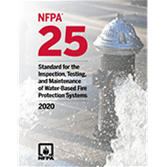Hydrostatic Testing: Changes to NFPA 25 Over the Decades


When is hydrostatic testing of standpipe systems and fire department connections required in accordance with NFPA 25: Standard for Inspection, Testing, and Maintenance of Water-Based Fire Protection Systems?
Since the inception of NFPA 25 in 1992, hydrostatic testing has been required on specific systems typically at five-year intervals. It is conducted to verify the integrity of a system. Typically, the requirement has been to test systems at 200 psi or 50 psi above the maximum pressure for two hours. For example, if a system has a maximum pressure of 175, then the system would require a hydrostatic test at 225 psi.
In the 1992 through 2002 editions of NFPA 25, hydrostatic testing is required on dry standpipe systems and dry portions of wet standpipe systems. The dry portion of the wet standpipe system is the fire department connection.
NFPA 25, 1992
6.3.2.1 Hydrostatic tests at not less than 13.8-bar (200-psi) pressure for 2 hours, or at 3.4 bar (50 psi) in excess of the maximum pressure, where maximum pressure is in excess of 10.3 bar (150 psi), shall be conducted every 5 years on dry standpipe systems and dry portions of wet standpipe systems.
The language was changed again in the 2011 edition from automatic dry to semiautomatic dry standpipe systems. This change was made because automatic dry systems are typically monitored by air, and a semiautomatic dry standpipe is typically a deluge system and not normally monitored by air pressure. The 2011 edition also changed the wording from dry portions of the wet system to specifically cite testing of the fire department connection.
NFPA 25, 2011
6.3.2.1 Hydrostatic tests of not less than 200 psi (13.8 bar) pressure for 2 hours, or at 50 psi (3.4 bar) in excess of the maximum pressure, where maximum pressure is in excess of 150 psi (10.3 bar), shall be conducted every 5 years on manual standpipe systems and semiautomatic dry standpipe systems, including piping in the fire department connection.
In the 2014 edition, a section was added in chapter 13 that requires hydrostatic testing at 150 psi from the fire department connection to the check valve. The language in chapter 6 did not change. This means that the fire department connection for manual dry standpipe and semiautomatic standpipe systems still need to be tested at 200 psi, and all other fire department connections are tested at 150 psi. The reason for this change was that 150 psi is the most frequently used operating procedure of fire departments when supporting fire protection systems.
NFPA 25, 2014
6.3.2.1* Hydrostatic tests of not less than 200 psi (13.8 bar) pressure for 2 hours, or at 50 psi (3.4 bar) in excess of the maximum pressure, where maximum pressure is in excess of 150 psi (10.3 bar), shall be conducted every 5 years on manual standpipe systems and semiautomatic dry standpipe systems, including piping in the fire department connection.
13.7.4 The piping from the fire department connection to the fire department check valve shall be hydrostatically tested at 150 psi (10 bar) for 2 hours at least once every 5 years.
NFPA 25 current requirements for hydrostatic testing
The 2017 and 2020 editions have not changed from the 2014 language.
Manual wet standpipes that are part of a combined sprinkler/standpipe system are not required to be hydrostatically tested in any edition. However, pipe from the fire department connection to the check valve is required to be tested at 150 psi in accordance with the 2014 edition and later.
The only other times that systems must be hydro tested is when repairs are made, and the component action tables found in NFPA 25 require appropriate testing. There are other areas within NFPA 25 that require hydrostatic testing, such as foam systems and water mist systems that were not addressed in this blog.
HAVE A QUESTION ABOUT FIRE PROTECTION? CONTACT THE NFSA TODAY
Members and employees of NFSA work very closely in the codes and standards development process. Our team of experts stay on the cutting edge of fire protection issues by participating in over 250 codes and standards development committees. If you have an interest in NFSA’s mission to protect lives and property through the widespread acceptance of the fire sprinkler concept, or you simply want to get more involved in the codes and standards process with NFSA, please visit our membership page.
Do you have questions about hydrostatic testing? NFSA offers numerous training on fire sprinkler inspection, testing, and maintenance. Additionally, members can reach out via our website or call 443-863-4464 for answers and support from our engineering and standards experts. Not an NFSA member yet? Join today!
For over a century, the National Fire Sprinkler Association (NFSA) has served as the voice of the fire sprinkler industry. Our mission: advocating to protect lives and property through the widespread acceptance of the fire sprinkler concept. To join NFSA or learn more about the ways membership can benefit your organization, visit nfsa.org/join.
